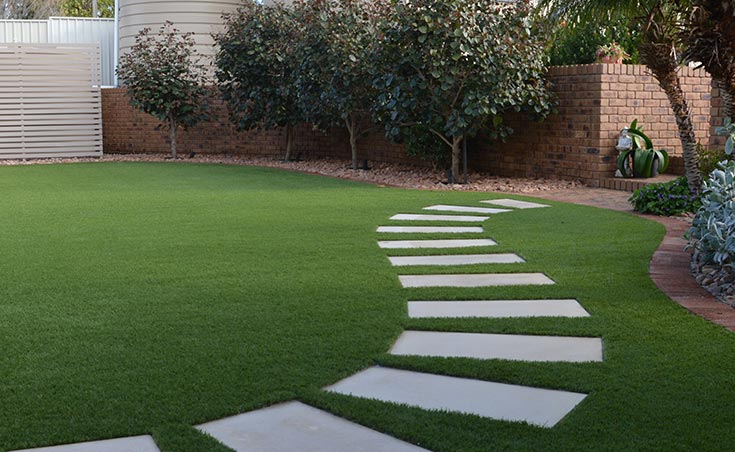
Table of Contents
Introduction
Imagine having a lush, green lawn all year round without the hassle of mowing, watering, or fertilizing. That’s the beauty of an artificial lawn! At The Turf Farm, we specialize in providing top-quality artificial lawns in Adelaide and expert advice on maintaining them. In this blog post, we will share essential maintenance and care tips to help you keep your artificial lawn looking pristine. Whether you are a homeowner, a garden enthusiast, or an eco-friendly consumer, these insights will ensure your lawn remains vibrant and durable for years.
The Benefits of Artificial Lawns
Eco-Friendly
Artificial lawns in Adelaide are an excellent choice for those looking to reduce their environmental footprint. Unlike natural grass, they do not require chemical fertilizers, pesticides, or excessive water. This means fewer pollutants and less water wastage, making it an eco-friendly option.
Low Maintenance
One of the main attractions of artificial lawns is their low maintenance requirements. Forget about mowing, edging, or seasonal fertilizing. With an artificial lawn, you can enjoy a beautiful yard with minimal effort, freeing up your weekends for relaxation and fun.
Durable
Artificial lawns are designed to withstand various weather conditions and heavy foot traffic. They are made from durable materials that resist wear and tear, ensuring your lawn stays lush and green for many years. This durability makes artificial lawns an excellent investment for homeowners.
Initial Installation Care
First Steps After Installation
After your artificial lawn is installed, it’s crucial to follow some initial care steps to ensure proper settling and rooting. Start by avoiding heavy foot traffic for the first 48 hours. This allows the adhesive to set and the lawn to stabilize.
Brushing
Gently brush the lawn to help the blades stand up straight and remove any installation debris. Use a soft-bristled brush and work in different directions to achieve a natural look. Brushing also helps to distribute the infill evenly, providing better support for the grass blades.
Watering
While artificial lawns don’t need regular watering, a light rinse can help settle the infill and remove any dust or debris. This is especially important in the first few days after installation. Use a garden hose with a gentle spray setting to avoid damaging the lawn.
Seasonal Maintenance Guide
Spring
Spring is the perfect time to give your artificial lawn a thorough cleaning. Remove any debris, leaves, or twigs that may have accumulated over the winter. A leaf blower or a rake can be handy for this task. Also, check for any areas that may need repair or additional infill.
Summer
During the hot summer months, your artificial lawn may experience increased foot traffic. Regularly brush the grass to keep the blades upright and maintain their appearance. If you notice any odors, a mixture of water and vinegar can help neutralize them. Simply spray the solution over the affected area and rinse with water.
Fall
In the fall, falling leaves can pose a challenge. Frequently remove leaves to prevent them from decomposing and causing mold. It’s also a good time to inspect the lawn for any wear and tear and make necessary repairs. Adding a bit of infill can help keep the grass blades standing tall.
Winter
Winter care for artificial lawns is relatively easy. Remove snow using a plastic shovel or a snow blower, but avoid using metal tools that could damage the turf. If ice forms, use a mixture of water and mild detergent to melt it, rather than harsh chemicals.
Troubleshooting Common Issues
Wear and Tear
Even though artificial lawns are durable, they can still show signs of wear over time. Regularly inspect high-traffic areas and brush the grass to redistribute the infill. If necessary, replace small sections with patch kits available from The Turf Farm.
Discoloration
Discoloration can occur due to various factors, such as UV exposure or spills. To prevent this, clean any spills immediately and use a UV protectant spray. For existing discoloration, consult with our experts at The Turf Farm for the best solutions.
Drainage Problems
Proper drainage is essential for maintaining an artificial lawn. If you notice water pooling, it could be a sign of poor drainage. Ensure the base layer is correctly installed and consider adding a drainage system if needed. Regularly clean the lawn to prevent clogging.
Conclusion
Maintaining an artificial lawn is simple and rewarding, especially with expert tips from The Turf Farm. By following our advice on installation care, seasonal maintenance, and sustainable practices, you can ensure your artificial lawn remains beautiful and functional for years. Remember, a well-maintained lawn not only enhances your home’s curb appeal but also contributes to a more eco-friendly lifestyle. For personalized guidance and more tips, connect with The Turf Farm experts today.